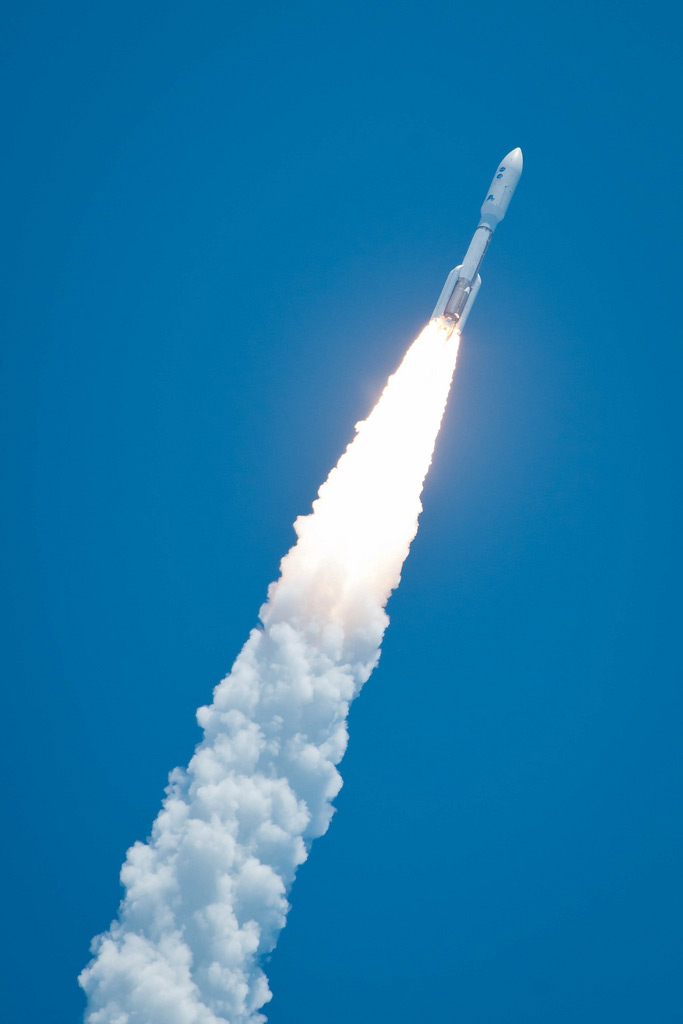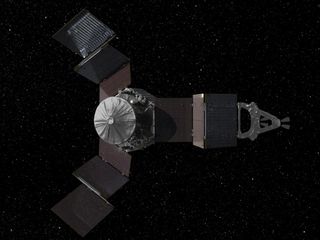
This story was updated at 1:26 p.m. EDT.
NASA's Juno spacecraft blasted off Friday (Aug. 5), kicking off a five-year journey to faraway Jupiter, the largest planet in the solar system.
Juno launched atop an unmanned Atlas 5 rocket Friday at 12:25 p.m. EDT (1625 GMT), streaking into the skies above Florida's Cape Canaveral Air Force Station. After a long and circuitous journey, the probe should settle into orbit around Jupiter in July 2016.
The rocket lifted off an hour later than planned, following a suspenseful countdown that encountered a few snags. The vehicle was initially slated to launch at 11:24 a.m. EDT (1534 GMT), but a helium leak in a ground system for the probe's Atlas 5 rocket caused the first delay, then officials needed to confirm that wayward boat was clear of the rocket's offshore launch range, forcing NASA to stall further. [Next Stop, Jupiter! Launch Photos of NASA's Juno Probe]
Both issues were resolved in time to launch the Atlas 5 before its one-hour window closed.
Next stop: Jupiter
Once at Jupiter, Juno will study the huge planet from orbit for one Earth year, helping scientists better understand how and when Jupiter came to be. Such information could shed light on planet formation processes and the evolution of our solar system, researchers said.
Get the Space.com Newsletter
Breaking space news, the latest updates on rocket launches, skywatching events and more!
"We're getting the ingredients of Jupiter," Juno principal investigator Scott Bolton, of the Southwestern Research Institute in San Antonio, told reporters Wednesday (Aug. 3). "We're going to understand what the structure is like inside — how is it built — and that'll kind of give us guidance as to what happened in that early time that eventually led to us."
Studying mysterious Jupiter
Gigantic Jupiter was greedy from the very beginning, gobbling up most of the gas and dust left over in the early solar system after the sun formed.
As a result, Jupiter became the king of the planets; it harbors twice as much mass as everything else in the solar system put together (excluding the sun). However, the gas giant rules in obscurity, for scientists still don't know much about Jupiter.
For example, they're not sure if the huge planet has a solid core of heavy elements, or if it's made entirely of gas. And it's unclear exactly how — and where — Jupiter formed.
The $1.1 billion Juno mission was designed to investigate these and other mysteries. After settling into a highly elliptical polar orbit around the planet five years from now, the spacecraft will study Jupiter's atmosphere and composition, as well as map its magnetic and gravitational fields.
Juno will measure the water content of Jupiter's thick, swirling atmosphere to gain insights about the planet's birth. A relatively wet Jupiter suggests it may have formed far away from the sun, then migrated in to its present position later, researchers have said.
"We are going to be using a microwave detector and fly just over the clouds of Jupiter, looking down at different cloud depths to measure the amounts of water below," said Juno co-investigator Fran Bagenal, of the University of Colorado, in a statement. "It’s a bit like doing a CT scan of Jupiter’s dense clouds."
Juno will also gauge Jupiter's gravitational and magnetic fields, in an effort to determine if the planet does indeed have a solid core — and, if so, how big it is.
Because the probe is flying over Jupiter's poles, it will get great looks at the giant planet's auroras — the phenomena we refer to on Earth as the Northern and Southern Lights. [Video: Key to Solar System's to be Probed at Jupiter]
Juno will take its photos in visible, ultraviolet and infrared light. In short, Jupiter has five years to prepare for its close-up.
The probe is also carrying a few special stowaways: three LEGO figurines representing the Roman god Jupiter, his wife Juno, and the 17th century Italian astronomer Galileo Galilei. Known as the "father of modern astronomy," Galileo was responsible for discovering the four largest Jovian moons. His legacy is also honored with a plaque being carried aboard Juno for the trip to Jupiter.

A solar-powered spacecraft
Juno, which weighs about 8,000 pounds (3,267 kilograms) will make its long journey powered by the sun — the first time a solar-powered craft has ever traveled as far out as Jupiter.
Jupiter orbits nearly 400 million miles (644 million kilometers) farther from the sun than Earth does. Out there, sunlight is 25 times less intense than it is here on our home planet.
So Juno needs some pretty serious light-collecting area to generate enough juice. The spacecraft boasts three different solar arrays, each as big as a tractor-trailer. The arrays' 18,698 solar cells will generate about 400 watts of power out at Jupiter — the equivalent of four 100-watt light bulbs.
When Juno finally gets to Jupiter in July 2016, it will settle into a highly elliptical polar orbit, coming as close as 3,107 miles (5,000 kilometers) from the gas giant's cloud-tops at its closest pass.
This proximity will afford great looks at the giant planet, but it's dangerous for Juno, too. Jupiter possesses the strongest radiation environment of any solar system body beyond the sun. So mission planners have encased Juno's sensitive instruments and electronics inside a titanium "vault" for protection.
Juno will make 33 orbits of Jupiter over its year-long operational life, then be crashed intentionally into the giant planet. Scientists want to make sure that Juno doesn't slam into — and potentially contaminate — any of Jupiter's moons, some of which may be capable of supporting life.
You can follow SPACE.com senior writer Mike Wall on Twitter: @michaeldwall. Follow SPACE.com for the latest in space science and exploration news on Twitter @Spacedotcom and on Facebook.
Join our Space Forums to keep talking space on the latest missions, night sky and more! And if you have a news tip, correction or comment, let us know at: community@space.com.

Michael Wall is a Senior Space Writer with Space.com and joined the team in 2010. He primarily covers exoplanets, spaceflight and military space, but has been known to dabble in the space art beat. His book about the search for alien life, "Out There," was published on Nov. 13, 2018. Before becoming a science writer, Michael worked as a herpetologist and wildlife biologist. He has a Ph.D. in evolutionary biology from the University of Sydney, Australia, a bachelor's degree from the University of Arizona, and a graduate certificate in science writing from the University of California, Santa Cruz. To find out what his latest project is, you can follow Michael on Twitter.